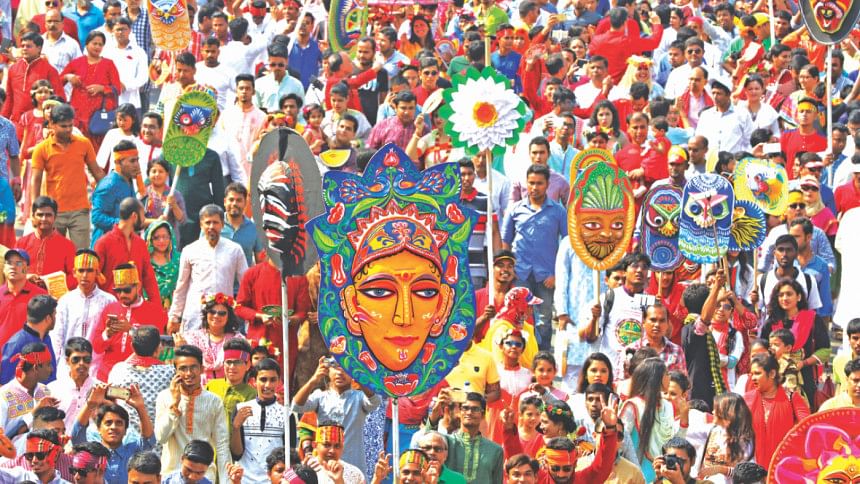Celebrating common threads

A society's culture can be broadly defined as its “way of life”—beliefs and customs generally shared by the people of that particular society. Culture, which is a complex, nuanced and multi-layered concept, is intrinsically related to one's religion, ethnicity, land, and language. But much as we desire it, in a diverse society, cultural homogeneity is a non-possibility as not everyone has the same set of beliefs or follows the same customs and rituals. Our's is a fractured culture of a fractured time, “a culture of many cultures”. It has been sliced up in so many ways that what's popular with one segment of the population may be quite unpopular with another segment. But certain ideas and norms, like respect for elders or love for the land that we belong to, have the ability to transcend these differences. Pahela Baishakh, the first day in the Bengali calendar, is one such element that can transcend differences. It gives us a sense of unity amidst our differences. At a time when divisions along religious, ethnic, political and linguistic lines are ripping apart the very fabric of our society, it gives us hope that maybe, deep inside, we still have what it takes to live together with some degree of dignity and respect for each other.
The history of Pahela Baishakh is tied with the history of the formulation of Bengali calendar, the origin of which is unclear. Some historians traced it to the rule of Mughal Emperor Akbar who wanted to create a “harvest calendar” for local residents in line with his taxation policy; others traced it to a much earlier time. Regardless of who adopted the calendar, the start of the traditional new year has been historically observed as an auspicious day for both farmers celebrating new harvest and traders looking for a fresh start in their businesses. But it was a simple, mostly private celebration, without the flashy trappings of modern-day celebrations. Celebrations of the kind that we see today, in cities and urban centres, are mostly modern inventions inspired by Baishakh-themed music, literature and folk art.
In 1967, Chhayanaut celebrated Pahela Baishakh as the first organisation to do so, a year after the revision of Bengali calendar that set April 14 as the first day of the Bengali New Year. Chhayanaut's move set an urban tradition of paying musical homage to the New Year that would, in later years, endure the onslaught of communal forces and political oppression. As the occasion grew in popularity, celebrations began to take new forms and new elements were introduced. Today, Pahela Baishakh is celebrated in numerous ways. You see village-style fairs, dance and musical events, readings, open-air concerts, kite festivals, special television programming, DJ parties, corporate-sponsored gigs, and so on and so forth. Inspired by these grand celebrations in Bangladesh, people in neighbouring Tripura and Kolkata, where until recently, Pahela Baishakh was mostly restricted to opening Halkhata (new ledger) and private gatherings, have also begun to accept it as a secular festival for Bengalis of all religions. After the UNESCO recognition of Mangal Shobhajatra, the staple of modern-day celebrations of Pahela Baishakh, it has turned into a symbol of national pride.
Pahela Baishakh has clearly come a long way since its humble, rural beginnings and spawned a regionwide multi-billion-taka bonanza. This, in turn, has also ignited some unpleasant questions about the way it is being celebrated today is the Bengali way. To put it differently, if Pahela Baishakh is part of the Bengali culture, does the way we celebrate it truly reflect that culture? You can hear murmurs of disapproval in some quarters that say that Islam, the religion of the majority, doesn't support a celebration that they think is largely inspired by Hindu myths and traditions; or doubt if latter-day inclusions like panta-ilish feasts and Mangal Shobhajatra really represent our centuries-old culture and heritage.
These are questions usually ignored by the mainstream media and the cultural elite and are often binned as products of a “fundamentalist” mindset. Doing so, however, only risks widening the existing schisms within our already deeply polarised society. I think critical thoughts, however biased or intellectually unsound, should be welcomed for the simple reason that they exist as a “reaction” which should give us an opportunity to evaluate our action. Also, such thoughts stem from genuine concerns and deserve appropriate response, the absence of which may very well mean the absence of a solid basis for the said action that has caused those concerns in the first place.
Is there really a “Bengali way” to celebrate Pahela Baishakh? Frankly, there isn't. We're too different to be alike. “Bengali way” in the sense of a single, linear way to be followed by everyone is a myth at best—and nationalist propaganda at worst. It is difficult to define because there is no single, universally accepted definition. About 98 percent of our population belongs to the Bengali ethno-linguistic group but Bangladesh is hardly ethnically homogeneous, so to speak, because of the different subgroups and deep divisions that exist within the larger ethno-linguistic group. And even then, religion plays a big part in how a certain cultural practice will be viewed, meaning even if it is accepted, its level of acceptance may vary depending on one's interpretation of it.
In Bangladesh, Muslims constitute 90.4 percent of the population while Hindus form 8.96 percent (2011 census). Defining the identity of Bengali Muslims from a historical perspective is not simple, according to Professor Anisuzzaman, a leading scholar on Bengali identity and culture. “When we identify a group of people as Bengali Muslim, we highlight only one aspect of their self-identity. But if we observe closely, we'll see that they contain multitudes,” he said. He drew on historical documents and literary sources to present a compelling picture of the diversity of Bengali Muslims in different ages in terms of their preference for language, attire, occupation, customs, and religious and political beliefs—which made them different not only from their Hindu counterparts, but also from each other. Defining the Bengali Hindus, on the other hand, is not an easy task either because they, too, have their differences, and went through a similar process of transformation. When we single out a certain way and try to pass it off as the Bengali way, to be followed by everyone, it serves as a denial of people's diversity and, in so doing, attains an autocratic quality.
Culture is a fluid concept. The freedom to navigate the complex situation that supposedly arises from one's linguistic, national and religious identities/differences lies at the heart of any pluralistic society, although cultural hegemons drumming up support for their vision of a unidimensional identity will make you think otherwise. They will cry hoarse about the illusive “Bangaliyana,” dig out age-old customs and disparage anyone who doesn't gravitate to them, but conveniently forget that such rigidity is an affront to those non-Bengali ethnic groups that also respect the traditional calendar and celebrate harvesting of new paddy in their own ways. The search for the Bengali way in Pahela Baishakh celebrations is, therefore, a misguided one. We need to seek unity through diversity. That being said, modern-day celebrations are a far cry from how Pahela Baishakh used to be celebrated, through simple feasts and fairs in rural areas. And the fact that it has been turned into an urban affair by people far removed from the reality of the peasant folks is an irony of the highest order.
The point I am trying to make is, Pahela Baishakh, while an integral part of the local culture and tradition, shouldn't be a cause for rifts simply because of some people's lofty idea of how to celebrate it or what the ideal Bengali way is. This, in part, also answers the questions, or reservations, about Pahela Baishakh from an Islamic perspective. Some Islamic scholars do no support celebrating Pahela Baishakh because of Mangal Pradip, panta-ilish feasts, Mangal Shobhajatra and other apparent Hindu influences. They mistakenly equate the spirit of Pahela Baishakh with its modern-day trappings. This, again, indicates how cultural hegemony has corrupted our understanding of Pahela Baishakh through the diffusion and popularisation of certain ways of celebration. But Pahela Baishakh is more than that. Pahela Baishakh is an idea—it will not change although how we celebrate it will. Pahela Baishakh is a celebration of life, a renewed awareness of what we are, what we used to be, and what we can achieve if we start together. Unlike Eids or Pujas, which come with a religious tag, Pahela Baishakh is a celebration for all. So what the religious scholars need to understand is that anyone can celebrate this day in their own unique way. Even a simple, unceremonious prayer for the wellbeing of the country, or a simple feast for orphans, would mean as much as organising big public galas.
What I find interesting is the secular message behind the first Mangal Shobhajatra organised in Dhaka in 1989. It was meant to be a creative expression of protest by the writers-artists who organised it, as part of their movement against the autocratic regime, which used religion to stay in power. The organisers, as a protest, wanted to do something that would highlight Bengali culture which is for the people of all religions. Hence, the idea of using symbols of different traditions. It was a deliberate attempt to underscore the importance of unity through diversity. That first walk was called “Ananda Shobhajatra.” I wonder if those who object to the naming of “Mangal” Shobhajatra today would have objected to “Ananda” Shobhajatra also.
Badiuzzaman Bay is a member of the editorial team at The Daily Star.
Email: [email protected]

 For all latest news, follow The Daily Star's Google News channel.
For all latest news, follow The Daily Star's Google News channel. 



Comments